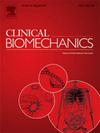Determinants of pivot kinematics in posterior stabilized total knee arthroplasty
IF 1.4
3区 医学
Q4 ENGINEERING, BIOMEDICAL
引用次数: 0
Abstract
Background
Restoring medial knee pivot kinematics post-total knee arthroplasty is widely recognized to enhance patient satisfaction. Our study investigates the kinematics of patients who received posterior stabilized implants via robotic-arm assisted surgery, specifically analyzing effects of implant alignment and soft tissue balance on pivot location.
Methods
Twelve high-functioning patients with unilateral posterior stabilizing knee implants underwent CT-guided robotic-arm assisted surgery. We then evaluated their knee kinematics using stereo radiography during gait, stair descent, lunge, seated knee extension and leg press. Femoral low-point condylar kinematics were used to calculate the transverse center of rotation, or pivot, using principal component analysis. Linear mixed effects regression was used to identify surgical parameters that influence pivot location across a flexion range.
Findings
Across all five activities a central pivot pattern emerged as the primary pivot location (40 %) followed by medial (25 %), no pivot (22 %) and lateral (14 %). Tibial medial resection depth and Tibial implant flexion-extension placement were significantly associated with shifting the pivot location laterally prior to cam-post engagement. Femoral implant external-internal implant placement, and medial compartment laxity in extension were significantly associated with shifting the pivot location laterally during the cam-post engagement, while femoral distal-lateral resection depth was associated with a medial shift.
Interpretation
Central and medial pivot locations are predominant in patients with posterior stabilized total knee arthroplasty, facilitated by robotic-arm assisted surgery. Despite significant associations between surgical parameters such as tibial medial resection depth and lateral compartment laxity with medial pivot, these variables explained a small portion of the variability in pivot location. This suggests that while surgical precision influences pivot kinematics, individual patient factors may play a more critical role, suggesting a need for further research into patient-specific biomechanics to optimize post-surgical outcomes.
后稳定全膝关节置换术中枢轴运动学的决定因素
背景全膝关节置换术后恢复膝关节内侧枢轴运动学被广泛认为可以提高患者满意度。我们的研究调查了通过机械臂辅助手术接受后稳定植入物的患者的运动学情况,特别分析了植入物排列和软组织平衡对枢轴位置的影响。然后,我们在步态、下楼梯、弓步、坐位膝关节伸展和压腿过程中使用立体放射摄影对他们的膝关节运动学进行了评估。股骨低点髁运动学数据被用来通过主成分分析计算横向旋转中心或枢轴。在所有五种活动中,中心枢轴模式是主要的枢轴位置(40%),其次是内侧(25%)、无枢轴(22%)和外侧(14%)。胫骨内侧切除深度和胫骨假体屈伸位置与凸轮柱啮合前枢轴位置向外侧移动密切相关。股骨内外侧假体置入和伸展时内侧室松弛与凸轮柱接合时枢轴位置向外侧移动有显著相关性,而股骨远外侧切除深度与内侧移动相关。尽管手术参数(如胫骨内侧切除深度和侧室松弛度)与内侧枢轴之间存在明显关联,但这些变量只能解释枢轴位置变异的一小部分。这表明,虽然手术精度会影响枢轴运动学,但患者的个体因素可能起着更为关键的作用,因此有必要进一步研究患者的特异性生物力学,以优化术后效果。
本文章由计算机程序翻译,如有差异,请以英文原文为准。
求助全文
约1分钟内获得全文
求助全文
来源期刊

Clinical Biomechanics
医学-工程:生物医学
CiteScore
3.30
自引率
5.60%
发文量
189
审稿时长
12.3 weeks
期刊介绍:
Clinical Biomechanics is an international multidisciplinary journal of biomechanics with a focus on medical and clinical applications of new knowledge in the field.
The science of biomechanics helps explain the causes of cell, tissue, organ and body system disorders, and supports clinicians in the diagnosis, prognosis and evaluation of treatment methods and technologies. Clinical Biomechanics aims to strengthen the links between laboratory and clinic by publishing cutting-edge biomechanics research which helps to explain the causes of injury and disease, and which provides evidence contributing to improved clinical management.
A rigorous peer review system is employed and every attempt is made to process and publish top-quality papers promptly.
Clinical Biomechanics explores all facets of body system, organ, tissue and cell biomechanics, with an emphasis on medical and clinical applications of the basic science aspects. The role of basic science is therefore recognized in a medical or clinical context. The readership of the journal closely reflects its multi-disciplinary contents, being a balance of scientists, engineers and clinicians.
The contents are in the form of research papers, brief reports, review papers and correspondence, whilst special interest issues and supplements are published from time to time.
Disciplines covered include biomechanics and mechanobiology at all scales, bioengineering and use of tissue engineering and biomaterials for clinical applications, biophysics, as well as biomechanical aspects of medical robotics, ergonomics, physical and occupational therapeutics and rehabilitation.
 求助内容:
求助内容: 应助结果提醒方式:
应助结果提醒方式:


